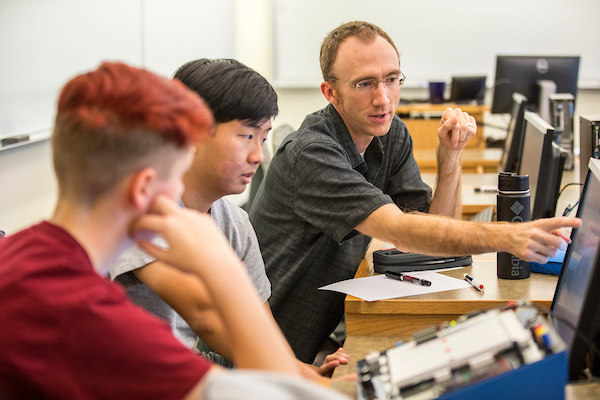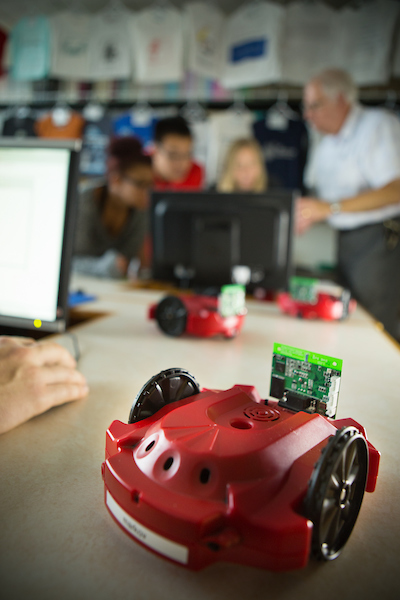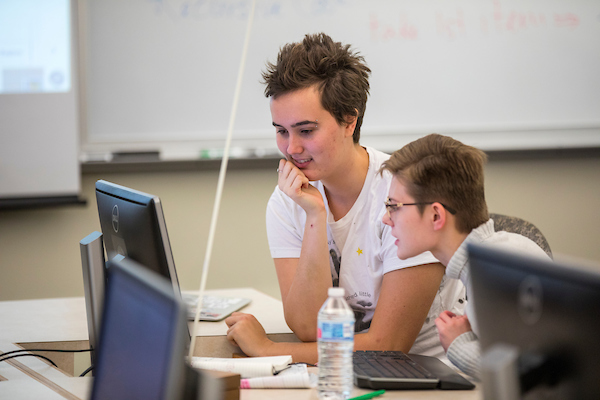pedagogy
Thursday Extra: "Building knowledge and confidence with mediascripting"
Mon, 2013-02-25 17:37 — stoneOn Thursday, February 28, Professors Sam Rebelsky, Janet Davis, and Jerod Weinman will discuss the rationale for using media scripting in our introductory computer science course:
Grinnell's CSC 151 draws upon concepts of media computation to motivate students and to provide more visual feedback that helps students better understand the algorithms they write. At the same time, CSC 151 encourages students to think about computing (and image making) in multiple ways. In this talk, a preview of a talk we will give at the SIGCSE Symposium on Computer Science Education, we discuss the inception of the course, what we see as key design points of the course, and the ways in which we have assessed the efficacy of the course. Since the introduction of this new version of 151, we have seen significant increases in enrollment and diversity. Assessments suggest that the course helps students develop deep knowledge that is atypical of an introductory course and also builds confidence.
Refreshments will be served at 4:15 p.m. in the Computer Science Commons (Noyce 3817). The talk, “Building knowledge and confidence with mediascripting: a successful interdisciplinary approach to CS1,” will follow at 4:30 p.m. in Noyce 3821. Everyone is welcome to attend!
- Login to post comments
Thursday Extra: "Keeping the millennials engaged with active learning"
Tue, 2010-04-06 10:58 — stoneAt 4:15 on Thursday, April 8, in Noyce 3821, Dr. Dan Garcia of the University of California - Berkeley will give a talk on his experience with a technological and pedagogical innovation:
When lecturing to a large class, one typically hears from a few, vocal participants, it's difficult to keep short-attention-span students engaged, there's no way to get high-resolution feedback, and there's no in-class learning community. Peer instruction with
clickersaddresses all these issues, and has been used in many classes at UC Berkeley with great success. We will share our experience using this technique for five years in a two-hundred-student sophomore computer-science class.
Refreshments will be served at 4:15 p.m. in the Computer Science Commons (Noyce 3817). The talk, Keeping the millennials engaged with active learning,
will follow at 4:30 p.m. in Noyce 3821. Everyone is welcome to attend!
- Login to post comments
Pedagogy

Grinnell's CS faculty delight in innovative pedagogy and blend several approaches within each course, according to the nature of the material under study. Students learn in different ways, making diversity of styles an important strength of courses. Most courses employ several styles, such as lectures, mini-lectures, group discussion, small group activities, large group activities, lab-based exercises, collaborative learning, and pair programming. Also, many CS courses meet daily within a lab environment, so that work may move between lab-based exercises and other activities, and this transition may take place several times within a single class session.

For example, introductory courses (e.g., CSC 151 and CSC 161) often follow a lab-based format and foster collaborative learning. After reading a short web-based discussion, students come to class for a lab that highlights ideas, allows experimentation with concepts, and applies principles to specific problems. Some exercises involve programming, others running experimenting, and still others comparing approaches. Students are encouraged to work in pairs on labs, while other assignments may involve involve individual work.
Through a typical class session in an introductory course, the instructor (aided by a upper-level student teaching assistant) circulates through the class, talking to each group, answering student questions, suggesting alternative approaches, and clarifying ideas. When similar issues arise from several students, the instructor may give a mini-lecture on the matter at hand. In this format, one instructor estimates he lectures about 4 hours per month—mostly in 10-minute pieces.

Similarly, upper-level courses often meet in a teaching lab, so that work can move easily from lecture to lab-based exercise to small group.
Feel free to explore the Web sites for our courses, past and present.
